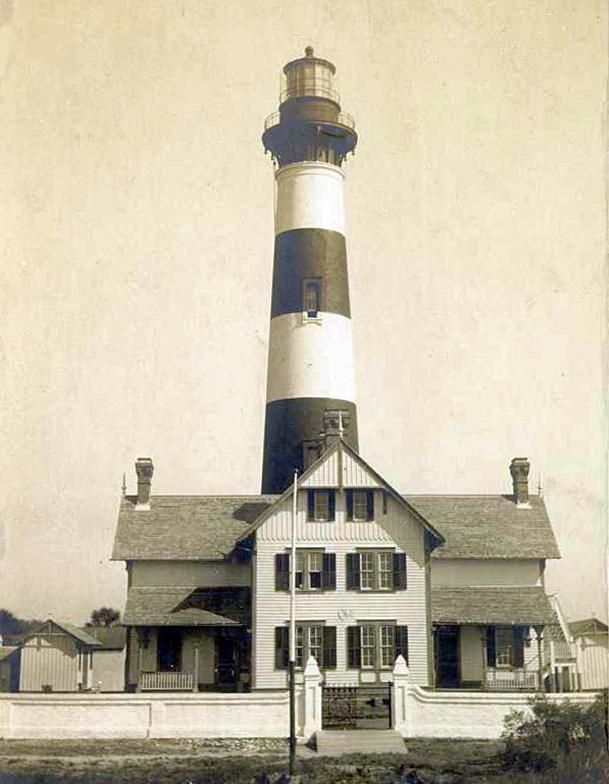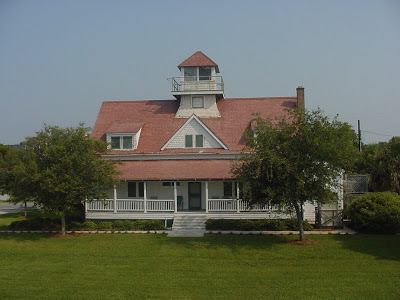Charleston Lighthouses
By Dan: Cowley, Flotilla Staff Officer for Navigation Services
In its more than four-hundred year history, shipping has always played a vital role in the Charleston area. The city is surrounded by water on three sides, contains a natural harbor protected from the open ocean by barrier islands, and has based the backbone for much of its economic well-being on maritime trade and fishing, while the surrounding area is dotted with barrier islands, wetlands, rivers and hundreds of miles of inland waterways. With such an emphasis placed on shipping, the role of lighthouses along the South Carolina coast also played a vital role in guiding ships into the harbor and warning mariners of dangers ahead. One of the most well-known lighthouses is the Morris Island Lighthouse, also known as The Charleston Light.

The Charleston Light, located on Morris Island at the entrance to the harbor of Charleston, SC, was one of the colonial lights turned over to the Federal Government under the terms of the act of August 7, 1789. The light was in a brick tower, built by the Colony of South Carolina in 1767. On May 7, 1800, Congress appropriated $5,000 for repairing the lighthouse. In 1838 the light was described as a revolving light, the tower being 102 feet from the base to the lantern. A new first-order lens was installed in the tower on January 1, 1858.

 On December 20, 1860, on receiving reports from the lighthouse inspector at Charleston regarding the probable seizure of the lighthouse property by the Confederacy, the Secretary of the Lighthouse Board wrote the Secretary of the Treasury that he would not recommend "that the coast of South Carolina be lighted by the Federal Government against her will." Ten days later the inspector at Charleston informed the Board that "the Governor of the State of South Carolina has requested me to leave the State. I am informed that forcible possession has been taken of the lights, buoys, etc., of this harbor, and that similar measures will be adopted in regard to all lights in the State." Early in January 1861, the Rattlesnake Shoal Lightship was towed into Charleston and the lighthouse tenders were seized. By the latter part of April 1861, practically all lights were extinguished, lightships removed, and other aids removed or destroyed from the Chesapeake to the Rio Grande, with the exception of some of the lights on the Florida coast and reefs.
On December 20, 1860, on receiving reports from the lighthouse inspector at Charleston regarding the probable seizure of the lighthouse property by the Confederacy, the Secretary of the Lighthouse Board wrote the Secretary of the Treasury that he would not recommend "that the coast of South Carolina be lighted by the Federal Government against her will." Ten days later the inspector at Charleston informed the Board that "the Governor of the State of South Carolina has requested me to leave the State. I am informed that forcible possession has been taken of the lights, buoys, etc., of this harbor, and that similar measures will be adopted in regard to all lights in the State." Early in January 1861, the Rattlesnake Shoal Lightship was towed into Charleston and the lighthouse tenders were seized. By the latter part of April 1861, practically all lights were extinguished, lightships removed, and other aids removed or destroyed from the Chesapeake to the Rio Grande, with the exception of some of the lights on the Florida coast and reefs.In 1862 the Lighthouse Board reported "Charleston, lens and lantern destroyed." In all, 164 lights were forcibly discontinued during the Civil War on the southern coasts. These were re-lit from time to time, and by 1866, the greater part had been restored. The Charleston Channel was re-marked promptly on the occupation of the city by Union troops in February 1865. In 1865 the Lighthouse Board reported "that an almost total change had taken place, leaving no channel in the harbor as it was in 1860, and opening new ones. Under this altered state of things it became necessary to establish lights temporarily at such places as would be useful guides through existing channels and omit all others.
On March 3, 1873, Congress made the first of three appropriations for a new lighthouse on Morris Island. $60,000 was granted on that date for "commencing the rebuilding of a first-order seacoast light on Morris Island destroyed during the war." Two other appropriations totaling $90,000 in 1874 and 1875 were for completing the work. The new structure was to be at or near the same spot as the old tower, 150 feet high and built of brick, with a first-order flashing light. Foundation piles were driven and the space between them filled with concrete 8 feet thick. The new tower, when completed in 1876, was 161 feet in height and the cost was $149,993.50. A first-order Fresnel lens was installed. In 1884 the illuminating apparatus was changed for the use of mineral oil instead of lard oil.

The cyclone of August 25, 1885, destroyed the rear beacon of the Morris Island range, overturned part of the brick wall which enclosed the tower and dwelling of the main light, carried away the bridge between the beacons, and destroyed a large part of the plank walks connecting the several lights and dwellings, and overturned the boathouse. The range was reestablished 3 days later by a temporary beacon. A new wooden skeleton structure 40 feet high was built in 1885.
The earthquake of August 1886 threw the lens of the main light out of position and cracked the tower extensively in two places, but not so as to endanger its stability. The lens was replaced and the cracks repaired without delay. Erosion of land caused the Coast Guard to begin construction of a new lighthouse in 1960. The new light was commissioned on June 15, 1962. The tower stands 163 feet high on the north side of Charleston Harbor entrance on Sullivan's Island.
Upon completion of its construction by the US Coast Guard in 1962, the Sullivan's Island Lighthouse began active duty marking the entrance to the busy port of Charleston. This lighthouse holds the distinction of being the last lighthouse built by the Coast Guard and is arguably the most modern lighthouse in the United States. It is even rumored to be the most powerful lighthouse in the Western Hemisphere.

The design of this lighthouse is quite unique and is unlike any other US lighthouse. One of the most unique features is the design of the tower itself. Triangular in shape with a concrete base and steel framework, the structure is protected from the elements by aluminum siding. It also has the distinction of being the only lighthouse using an elevator to take Coast Guard personnel to the lantern room for maintenance, instead of the typical spiral staircase found in most lighthouses.
Soaring 140 feet in height, it broadcasts its beam 163 feet above sea level. It is equipped with two rotating beacons, each of which is capable of producing a beam with an intensity of 28 million-candle power. The lights enable the lighthouse to be seen 26 miles out to sea in clear weather. The lighthouse itself is not open to the public. However, the grounds are open to visitors during the day. There is not much to do at the lighthouse except take pictures and look around. Beach access is available at the lighthouse and good shots can be taken from the beach. Make sure you photograph the Sullivan's Island Life Saving Station which sits just behind the lighthouse. To get there, once in Mt. Pleasant, take SC-703 south. Cross the Ben Sawyer Memorial Bridge to Sullivan’s Island. Take a right at the stop sign onto Middle Street and follow it to Station 18½.
